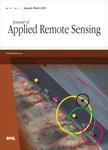版权所有:内蒙古大学图书馆 技术提供:维普资讯• 智图
内蒙古自治区呼和浩特市赛罕区大学西街235号 邮编: 010021

作者机构:KN Toosi Univ Technol Fac Civil Engn Dept Water Resources Tehran Iran
出 版 物:《JOURNAL OF APPLIED REMOTE SENSING》 (J. Appl. Remote Sens.)
年 卷 期:2017年第11卷第4期
核心收录:
学科分类:0830[工学-环境科学与工程(可授工学、理学、农学学位)] 1002[医学-临床医学] 070207[理学-光学] 07[理学] 08[工学] 0816[工学-测绘科学与技术] 0803[工学-光学工程] 0702[理学-物理学]
主 题:Landsat imagery index-based approach artificial intelligence algorithm meta-heuristic algorithms water extents
摘 要:Identification of water extents in Landsat images is challenging due to surfaces with similar reflectance Landsat images were selected from various environmental regions in Iran. Training of the algorithms was performed using 40 water pixels and 40 nonwater pixels in operational land imager images of Chitgar Lake (one of the study regions). Moreover, high-resolution images from Google Earth were digitized to evaluate the results. Two approaches were considered: index-based and artificial intelligence (AI) algorithms. In the first approach, nine common water spectral indices were investigated. AI algorithms were utilized to acquire coefficients of optimal band combinations to extract water extents. Among the AI algorithms, the artificial neural network algorithm and also the ant colony optimization, genetic algorithm, and particle swarm optimization (PSO) meta-heuristic algorithms were implemented. Index-based methods represented different performances in various regions. Among AI methods, PSO had the best performance with average overall accuracy and kappa coefficient of 93% and 98%, respectively. The results indicated the applicability of acquired band combinations to extract accurately and stably water extents in Landsat imagery. (C) 2017 Society of Photo-Optical Instrumentation Engineers (SPIE)